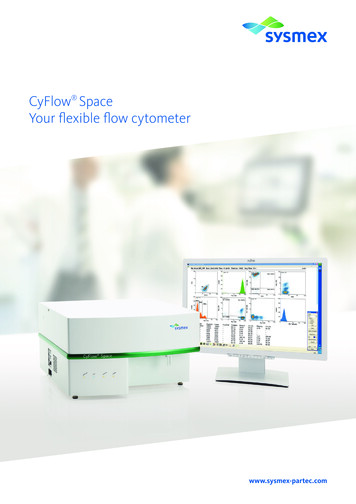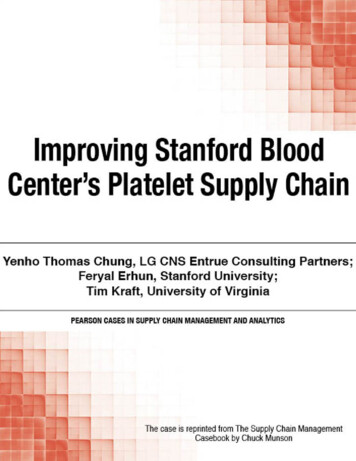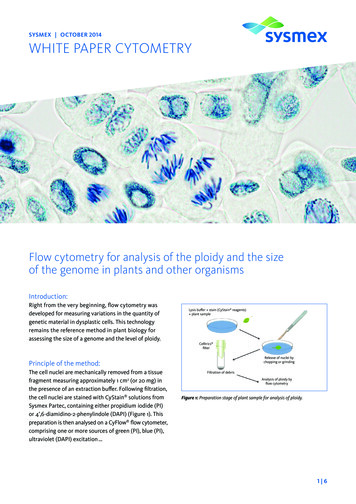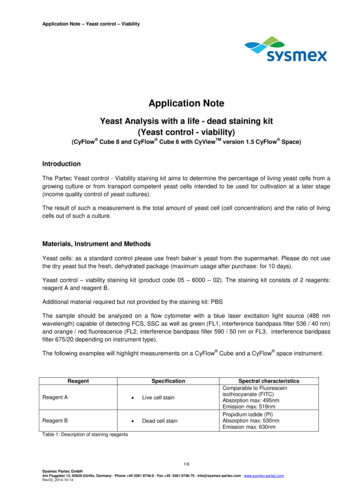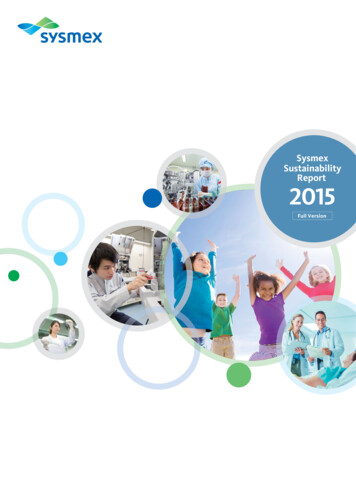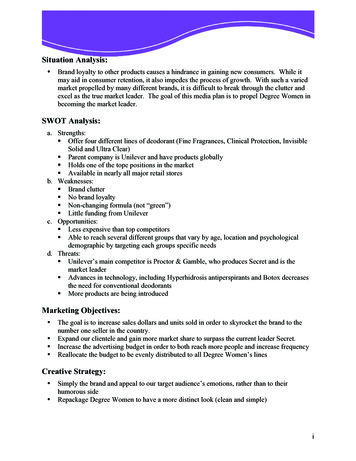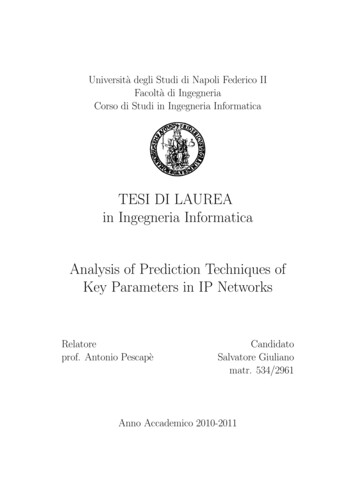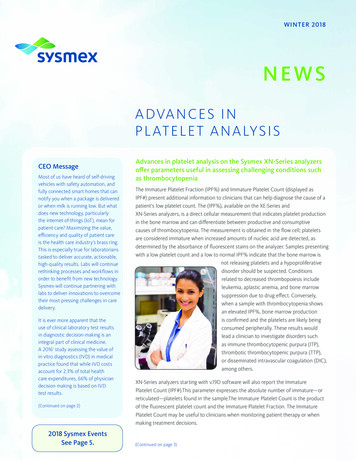
Transcription
WINTER 2018NEWSA DVA N C E S I NP L AT E L E T A N A LYS I SCEO MessageMost of us have heard of self-drivingvehicles with safety automation, andfully connected smart homes that cannotify you when a package is deliveredor when milk is running low. But whatdoes new technology, particularlythe internet-of-things (IoT), mean forpatient care? Maximizing the value,efficiency and quality of patient careis the health care industry’s brass ring.This is especially true for laboratorianstasked to deliver accurate, actionable,high-quality results. Labs will continuerethinking processes and workflows inorder to benefit from new technology.Sysmex will continue partnering withlabs to deliver innovations to overcometheir most pressing challenges in caredelivery.It is ever more apparent that theuse of clinical laboratory test resultsin diagnostic decision-making is anintegral part of clinical medicine.A 20161 study assessing the value ofin vitro diagnostics (IVD) in medicalpractice found that while IVD costsaccount for 2.3% of total healthcare expenditures, 66% of physiciandecision making is based on IVDtest results.(Continued on page 2)2018 Sysmex EventsSee Page 5.Advances in platelet analysis on the Sysmex XN-Series analyzersoffer parameters useful in assessing challenging conditions suchas thrombocytopeniaThe Immature Platelet Fraction (IPF%) and Immature Platelet Count (displayed asIPF#) present additional information to clinicians that can help diagnose the cause of apatient’s low platelet count. The (IPF%), available on the XE-Series andXN-Series analyzers, is a direct cellular measurement that indicates platelet productionin the bone marrow and can differentiate between productive and consumptivecauses of thrombocytopenia. The measurement is obtained in the flow cell; plateletsare considered immature when increased amounts of nucleic acid are detected, asdetermined by the absorbance of fluorescent stains on the analyzer. Samples presentingwith a low platelet count and a low to normal IPF% indicate that the bone marrow isnot releasing platelets and a hypoproliferativedisorder should be suspected. Conditionsrelated to decreased thrombopoiesis includeleukemia, aplastic anemia, and bone marrowsuppression due to drug effect. Conversely,when a sample with thrombocytopenia showsan elevated IPF%, bone marrow productionis confirmed and the platelets are likely beingconsumed peripherally. These results wouldlead a clinician to investigate disorders suchas immune thrombocytopenic purpura (ITP),thrombotic thrombocytopenic purpura (TTP),or disseminated intravascular coagulation (DIC),among others.XN-Series analyzers starting with v.19D software will also report the ImmaturePlatelet Count (IPF#).This parameter expresses the absolute number of immature—orreticulated—platelets found in the sample.The Immature Platelet Count is the productof the fluorescent platelet count and the Immature Platelet Fraction. The ImmaturePlatelet Count may be useful to clinicians when monitoring patient therapy or whenmaking treatment decisions.(Continued on page 3)
M E S SAG E F RO M T H E C E O(Continued from cover)Although laboratory science is the medical profession that almost all working physicians rely on,lab test training is limited within the curriculum of many medical schools. This conundrum furtherhighlights the important role laboratorians play in delivering quality care. At Sysmex, we are keenlyaware of the central position labs hold within the health care system.February 2018 will mark Sysmex’s 50 year anniversary. Since 1968, Sysmex has sought to solvehealth care diagnostic challenges with world-class technology and proprietary R&D to expand thepossibilities for delivering patient care that always prioritizes value, quality and continuous labperformance improvement. Fittingly, in 2017 Sysmex America introduced the most new products tomarket in a single year than ever before—17 products in 2017.Ralph Taylor, CEO, Sysmex AmericaThe expansion of our portfolio is an exciting prelude to our 50 year anniversary. The 17 productslaunched last year provide solutions to answer the industry’s call for better, more-efficientperformance through innovations that streamline communication, support laboratory professionaldevelopment, comprehensively refine lab systems and implement better diagnostic reporting andquality monitoring to support the overall diagnostic process.While the broadening of our product portfolio with 17 new products in 2017 is a source of satisfactionand an example of our genuine, health-focused scientific curiosity, the work I’m most proud of arethe solutions that provide you the customer the clinical and operational value that make real worlddifferences to patients. Looking ahead to 2018, partnerships with innovative companies like PTC,maker of Thingworx technology, will continue to allow us to deliver intuitive digital integrations thatenhance situational awareness, track behavior, provide sensor-driven data for faster decision-makingand seize new opportunities for process optimization.Similar to our modern day reliance on mobile technology to problem solve, communicate andorganize our lives, my belief is that Sysmex will bring revolutionary value and quality to your workand to patient care for another 50 years. We will continue to chart the course for greater innovationthat moves beyond the procedural, though important, and to the interactive innovations thathelp customers like you best enact your work in the laboratory. New technology will offer unique,adaptable, holistic solutions that support testing from the moment lab orders are submitted, todelivery of clinically actionable results. We will continue to help lab professionals leverage Sysmextechnology to enhance the service they provide patients every day, in 2018 and beyond a better box.Wishing you a wonderful 2018 Sincerely,Ralph TaylorChief Executive OfficerRohr, U.-P., Binder, C., Dieterle, T., Giusti, F., Messina, C. G. M., Toerien, E., Schäfer, H. H. (2016). The Value of In Vitro Diagnostic Testingin Medical Practice: A Status Report. PLoS ONE, 11(3), e0149856. http://doi.org/10.1371/journal.pone.014985612SYS M E X N E W S
A DVA N C E S I N P L AT E L E T A N A LYS I S(Continued from cover)For more information about the immature platelet parameters, please visit our new Advanced Clinical Parameter (ACP)website (see below) at www.sysmex.com/acplab. From this site, you can view related articles, watch videos discussingthe clinical utility of our ACPs, or read about how other Sysmex users utilize ACPs to gain efficiency in their laboratory orclinical practice. Also, be sure to click on the “Training and Education” link to check out our upcoming Spring Webinar Series,featuring “Evaluation of Anemia and Thrombocytopenia in Neonates” on February 14 by Martha Sola-Visner, MD, of BostonChildren’s Hospital and Harvard Medical School. You can also register for a future event or explore our entire list ofon-demand webinars, all of which offer CEUs. We encourage you to check out our websitewww.sysmex.com/acplab and shareinformation specific to the ACPs withyour team! e have updated our external websiteWto include ACP materials for bothlaboratorians and practitioners. ontent is categorized according toCpractitioner specialty and patientdisease type. aterials include links to recentMpublications, videos, white papers,customer testimonials, and more.WINTER 20183
MEASURING THE DNA CONTENT OF PLANTSA Departure From Clinical Cell Analysis for Sysmex!Unlike humans, the nuclei of plants often contain large variations in the number ofchromosome sets they contain (ploidy)1. For example, human nuclei contain two sets ofchromosomes (diploid), whereas potatoes contain 4 sets of chromosomes in their nuclei(tetraploid). Determining ploidy is therefore a particularly important form of analysis in plantbreeding and aquaculture. Controlling the ploidy level is often essential for monitoring theoutcome of breeding procedures and quality in seed and plant production. As such, accuratelydetermining genome size and ploidy levels plays a major role in today’s evolutionary biology,taxonomy and ecology. It helps to characterize and understand how species develop and thedetails of population structures.Until recently, chromosomes were counted using classical light microscopy, but this has beenreplaced by flow cytometry, a method that is time-and cost-saving, as it provides preciseresults quickly with an efficient work-flow. Flow cytometry is now the gold standard the stateof-the-art method in the breeding industry and in research for determining both the ploidylevel and genome size in plants, animals and microorganisms.In order to visualize chromosomal DNA, cells are disrupted and the chromosomes are thenstained with a fluorescent dye such as propidium iodide or DAPI stain2 , after which flowcytometry is used to measure the fluorescence produced by the dye, created by exciting thedye with a laser. Fluorescence data is then displayed on histograms, showing the ploidy level.Sysmex offers a range of reagents and flow cytometry systems for ploidy analysis. If you want to learn more, view on this linkhttps://us.sysmex-flowcytometry.com. References1Plant polyploidy and the evolutionary ecology of plant/animal interactions. John N. Thompson, Scott L. Nuismer, Kurt Merg. Biological Journal of the Linnean Society,Volume 82, Issue 4, 1 August 2004, Pages 511–519.2 Analysis of Cellular DNA Content by Flow and Laser Scanning Cytometry. Zbigniew Darzynkiewicz,* H. Dorota Halicka, and Hong Zhao. Adv Exp Med Biol. 2010;676: 137–147.Number of nuclei (vertical axis) and fluorescence intensity (horizontalaxis) Zea mays (Maize), 2n - diploid, CyStain DAPI staining.4SYS M E X N E W SNumber of nuclei (vertical axis) and fluorescence intensity (horizontalaxis) Zea mays (Maize), 4n - tetraploid, CyStain DAPI staining.
SYS M E X E V E N T S 2018February 3 – 7, 2018North American Veterinary Meeting & ExpoOrange County Convention CenterOrlando, FLFebruary 14, 2018Evaluation of Anemia and Thrombocytopeniain NeonatesSysmex WebinarNoon Central TimeMarch 11 – 15, 2018Society of Toxicology ExpoHenry B. Gonzalez Convention CenterSan Antonio, TXApril 14 – 18, 2018American Association for Cancer ResearchMcCormick Place North/SouthChicago, ILMay 4 – 8, 2018Immunology 2018 Annual ConventionAustin Convention CenterAustin, TXJune 1 – 5, 2018American Society of Clinical OncologyMcCormick PlaceChicago, ILJune 14 – 16, 2018American College of Vet Internal MedicineWashington State Convention CenterSeattle, WAJuly 13 – 17, 2018American Vet Medical AssociationColorado Convention CenterDenver, COJuly 29 – August 2, 2018American Association for Clinical Chemistry(AACC) Annual MeetingMcCormick PlaceChicago, ILOctober 13 – 16, 2018American Association of Blood Banks (AABB)Annual MeetingBoston Convention CenterBoston, MANovember 1 – 3, 2018American Molecular PathologyHenry B. Gonzalez Convention CenterSan Antonio, TXWINTER 20185
SYSMEX AMERICA AND CLEARBROOKPARTNERSHIP EXTENDEDPartnership to employ people withdevelopmental disabilities keeps reagentfactory humming alongDon Marquis with Marilyn atClearbrook’s Palatine, Illinois facility.From living accommodationsand transportation, to familysupport and employmentservices, Don Marquis,director of corporate relationsfor Clearbook, funnelspassion into the organization,whose mission is to provideinnovative opportunities,services and support topeople with disabilities.Specifically, Clearbrookis committed to creatinginnovative employmentopportunities for people livingwith disabilities.skills training for a variety of work, from food service, painting andlandscaping, to manufacturing production like the work completedat SRA.Delivering on Clearbrook’s mission, Marquis’ work life is devoted toattesting to the value of hiring workers with disabilities and spreadingthe word about the quality work they can offer. “Embracing allabilities opens opportunities for new innovations that are fruitful forcompanies and the people who they employ,” said Marquis. Studiesshow that diverse teams deliver benefits to overall company cultureand business success. In fact, businesses that embrace disabilityinclusion have found a positive correlation between profitability,employee morale and engagement. As well as finding lower turnover,better safety records, increased innovation and greater productivityamong employees.In 2017 Sysmex America andClearbrook extended theiremployment agreement, which provides capable job talent tothe reagent factory, Sysmex Reagents America (SRA) located inMundelein, Illinois, about 30 minutes north of Chicago.For more than 60 years Clearbrook has served the needs of peopleliving with disabilities and their families, providing a broad arrayClearbrook Job Coach, Lynette Pancratz at Sysmex ReagentAmerica factory in Mundelein, Illinois.Sysmex America and Clearbrook began their relationship in 2011shortly after opening the then new SRA reagent production facilityin Illinois. “We sought synergistic opportunities to hire competentemployees at all skill levels, while delivering on the company missionto deliver quality products, and supporting the communities wherewe work—the Sysmex Way,” said John Neal, Sr. Director for SysmexOperations.Stuart and Leanne greeting people at Clearbrook.of support services that improve quality of life for families, as wellas the in the communities where they work. As for employment,the nonprofit coordinates job recruitment, achievement and6SYS M E X N E W SThe Sysmex Way is the corporate philosophy that is a cornerstone forall Sysmex activities. It defines and guides company pursuits throughits mission to shape healthcare’s future, create unique and innovativevalue that builds trust and confidence, and the mindful demonstrationof competence and teamwork. Their relationship with Clearbrookdemonstrates the Sysmex Way in action by providing uniquecommunity value that also delivers valuable personnel to Sysmex.
opportunities for clients to work and interact with membersof the community. The interaction between SRA associatesand Clearbrook clients has developed into a work relationshipembracing respect and trust,” said Threats. The benefits theyprovide the organization are clear. The connection, interactionand learning are benefits to the organization that Clearbrookemployees provide.Rochelle at Clearbrook in Palatine, Illinois facility.“We identified opportunities in the packaging andlabeling areas that were a great fit for Clearbrookfacilitated employees,” said Neal. “It’s been a long-runningand successful relationship that exemplifies the SysmexWay and provides us quality work from highly engagedemployees.”As for the day-to-day experience working with Clearbrooktalent, Derwin Threats, SRA production manager andShuji Nagai, director of manufacturing see the impact oftheir work daily. Threats works with coaches who provideadditional direction to Clearbrook employees on-siteand works to teach them the job of the day. Togetherthey coordinate schedules, shifts and instructions forcompleting the work safely, efficiently and effectively.“The Clearbrook agreement allows SRA to provide“Everyone has something to learn, including at SRA. Whiledifferences exist, the ability to perform quality work is to berespected,” said Nagai. “Though initially we had concernsabout safety within the manufacturing environment, theyshowed and proved their success. They have a strong workethic. Just because someone has a disability does not meanthey are not completely qualified to do a variety of jobs.”Clearbrook expands opportunities for people withdisabilities to contribute and develop career skills for greaterindependence and autonomy in their lives. The partnershipis one way that Sysmex America demonstrates the SysmexWay’s directive to increase value within its communities,while simultaneously gaining the real-life business benefits ofemploying diverse quality talent.For more information about Clearbrook and the myriad waysto show your support, visithttps://www.clearbrook.org. Clearbrook employees Michael and Adam working at SRAMundelein factory.WINTER 20187
WHAT’S NEW2018 Calendar PhotosThe 2018 Customer Calendar Contest is complete. This year’s theme, Lab Superheroes, is a celebration of lab professionals.Thanks to all of the customers who submitted photos. Here are just a few of the submissions received.Exeter Hospital in Exeter, New HampshireTeri Mullen, Suzanne Fletcher,Patricia Magdalenski, and Christine JohnsonManatee Memorial Hospitalin Bradenton, FloridaChris Tran, Martha Sutherland,Linda Jacobs, Isobel Anderson,Laarni Sesante, Lisa Beauregard,Rita Renzelmann, Linda Mann8SYS M E X N E W S
University Suburban Health CenterLaboratory in Cleveland, OhioTatiana Weaver, Clive Hamlin, Dan Ferrer,Dina Oriani, Zayra Ramos-Ortiz,Martha Adams, Rachel WoodsCancer & Hematology Centers of WesternMichigan in Grand Rapids, MichiganStephanie Tidd, Karrie Bittner,Melanie Dykstra, Linda DeVane,Carolyne King-KenyonNorton Sound Health CorporationSkyler Harbour, Hare Shah,Scharre Henry, Kyle ScottWINTER 20189
WHAT’S NEWChristus Santa Rosa Hospital-Westover Hillsin San Antonio, TXTracy Holmes Brazil, Devaki Allen, Jennell Chu,Erika Davila-Morales, Leslie Esubedo,Niché Johnson, Susan Mann, Leydi K. Reyba,Hazel Jane P-RianSt. Luke’s Hospital, AndersonCampus in Easton, PAChristine Eagle, Marie Koehler, Taina Garcia,Dilip Sheth, Casey Sousa, Jessica Smith,Danielle Roy, Julia Kester,Amber Adams, Danelle RoyUniversity of Ohio Hospital in Cleveland, OHDon Landek, Amanda Zimmerman, Terri Ponchak,Christine Hoyle, Kerry Schade, Jamie Meyers,Molly Klima, Crystal Leonard, Barb Staller,Christine Dillman, Dorren Losh, Jenny Branisel10SYS M E X N E W S
Sysmex Technology and Employee Know-How Provide Life-Saving Support with TACCynthia Webb, Technical Support Specialist III for Sysmex America, only had to ask a few questions before she realizedsomething was very wrong with the results a radiology technician was sharing during a standard customer support call. It wasn’tuntil much later, that the caller or anyone else, would realize how dire the situation really was.Webb received the call from the x-ray technologist to the Sysmex’s Technical Assistance Center (TAC) where she providescustomer technical support and troubleshoots their technical challenges. The customer, operating under the appropriate clinicalsupervision, was having troubles understanding test results and suspected that the sample was damaged. The customer, usingthe XN-1000, had difficulty reading a single sample due to aspiration and low blood volume errors.After some routine questions Cynthia logged on to the Sysmex Network Communications System (SNCS), the networking portalthat allows service teams like TAC to screen share with customers in order to deliver hands-on support remotely. Once loggedon, she was able to review the customers’ results directly.While analyzing the charts she confirmed the sample was good, but noticed a very low red blood cell count. The patient, a 13 yearold girl, had very low hematocrit levels, the lowest Webb had ever seen.Based on this service call, the results were submitted to the doctor who was then able to confirm that the patient hadundiagnosed leukemia. With the correct diagnosis confirmed, the doctor was able to develop, communicate and begin a planto treat the girl. Cynthia Webb was able to become the Medical Technologist remotely and confirm accurate results for betterclinical care. Technology and TAC representative knowledge enabled the customer to receive support with an experiencedMedical Technologist by their side.Cynthia, who recently celebrated her 25th anniversary with this Sysmex in 2017, said “I am glad that the customer wasappreciative, but it’s all in a day’s work with TAC. This is not an isolated instance. We get many calls where we assist customerswith unusual samples.
is the health care industry’s brass ring. This is especially true for laboratorians tasked to deliver accurate, actionable, high-quality results. Labs will continue . the nonprofit coordinates job recruitment, achievement and skills training for a variety of work, from food service, paint
